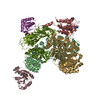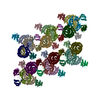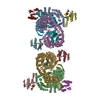[English] 日本語
 Yorodumi
Yorodumi- PDB-8d4d: gamma-Arf1 mediated dimeric assembly of AP-1, Arf1, Nef complex w... -
+ Open data
Open data
- Basic information
Basic information
| Entry | Database: PDB / ID: 8d4d | ||||||||||||
|---|---|---|---|---|---|---|---|---|---|---|---|---|---|
| Title | gamma-Arf1 mediated dimeric assembly of AP-1, Arf1, Nef complex within lattice on MHC-I lipopeptide incorporated narrow membrane tubes | ||||||||||||
 Components Components |
| ||||||||||||
 Keywords Keywords | PROTEIN TRANSPORT / nef / AP / trafficking | ||||||||||||
| Function / homology |  Function and homology information Function and homology informationbasolateral protein secretion / negative regulation of CD4 production / perturbation by virus of host immune response / mitotic cleavage furrow ingression / endosome to melanosome transport / trans-Golgi Network Vesicle Budding / AP-1 adaptor complex / Lysosome Vesicle Biogenesis / protein trimerization / platelet dense granule organization ...basolateral protein secretion / negative regulation of CD4 production / perturbation by virus of host immune response / mitotic cleavage furrow ingression / endosome to melanosome transport / trans-Golgi Network Vesicle Budding / AP-1 adaptor complex / Lysosome Vesicle Biogenesis / protein trimerization / platelet dense granule organization / Glycosphingolipid transport / regulation of receptor internalization / melanosome assembly / Intra-Golgi traffic / symbiont-mediated suppression of host antigen processing and presentation of peptide antigen via MHC class I / regulation of Arp2/3 complex-mediated actin nucleation / Golgi to vacuole transport / symbiont-mediated suppression of host antigen processing and presentation of peptide antigen via MHC class II / Synthesis of PIPs at the Golgi membrane / Golgi Associated Vesicle Biogenesis / symbiont-mediated suppression of host apoptosis / clathrin adaptor activity / suppression by virus of host autophagy / MHC class II antigen presentation / CD4 receptor binding / Nef Mediated CD4 Down-regulation / thioesterase binding / dendritic spine organization / determination of left/right symmetry / long-term synaptic depression / clathrin-coated vesicle / COPI-dependent Golgi-to-ER retrograde traffic / positive regulation of memory T cell activation / Lysosome Vesicle Biogenesis / T cell mediated cytotoxicity directed against tumor cell target / TAP complex binding / positive regulation of CD8-positive, alpha-beta T cell activation / clathrin binding / CD8-positive, alpha-beta T cell activation / Golgi medial cisterna / Golgi Associated Vesicle Biogenesis / positive regulation of CD8-positive, alpha-beta T cell proliferation / CD8 receptor binding / cell leading edge / MHC class I protein binding / antigen processing and presentation of exogenous peptide antigen via MHC class I / Synthesis of PIPs at the plasma membrane / endoplasmic reticulum exit site / host cell Golgi membrane / antigen processing and presentation of endogenous peptide antigen via MHC class I via ER pathway, TAP-dependent / TAP binding / protection from natural killer cell mediated cytotoxicity / intracellular copper ion homeostasis / beta-2-microglobulin binding / protein targeting / COPI-mediated anterograde transport / T cell receptor binding / detection of bacterium / clathrin-coated pit / vesicle-mediated transport / regulation of calcium-mediated signaling / viral life cycle / MHC class II antigen presentation / Gene and protein expression by JAK-STAT signaling after Interleukin-12 stimulation / Neutrophil degranulation / sarcomere / kidney development / small monomeric GTPase / trans-Golgi network membrane / Nef mediated downregulation of MHC class I complex cell surface expression / antigen processing and presentation of endogenous peptide antigen via MHC class Ib / antigen processing and presentation of endogenous peptide antigen via MHC class I via ER pathway, TAP-independent / Endosomal/Vacuolar pathway / Antigen Presentation: Folding, assembly and peptide loading of class I MHC / lumenal side of endoplasmic reticulum membrane / intracellular protein transport / virion component / trans-Golgi network / peptide antigen assembly with MHC class I protein complex / ER to Golgi transport vesicle membrane / cytoplasmic vesicle membrane / MHC class I peptide loading complex / T cell mediated cytotoxicity / positive regulation of T cell cytokine production / antigen processing and presentation of endogenous peptide antigen via MHC class I / cellular response to virus / MHC class I protein complex / SH3 domain binding / positive regulation of T cell mediated cytotoxicity / positive regulation of type II interferon production / recycling endosome membrane / phagocytic vesicle membrane / peptide antigen binding / Immunoregulatory interactions between a Lymphoid and a non-Lymphoid cell / Interferon gamma signaling / Interferon alpha/beta signaling / E3 ubiquitin ligases ubiquitinate target proteins / antibacterial humoral response / heart development / presynapse Similarity search - Function | ||||||||||||
| Biological species |  Homo sapiens (human) Homo sapiens (human)  Human immunodeficiency virus 1 Human immunodeficiency virus 1 | ||||||||||||
| Method | ELECTRON MICROSCOPY / subtomogram averaging / cryo EM / Resolution: 9.6 Å | ||||||||||||
 Authors Authors | Hooy, R.M. / Hurley, J.H. | ||||||||||||
| Funding support |  United States, 3items United States, 3items
| ||||||||||||
 Citation Citation |  Journal: Sci Adv / Year: 2022 Journal: Sci Adv / Year: 2022Title: Self-assembly and structure of a clathrin-independent AP-1:Arf1 tubular membrane coat. Authors: Richard M Hooy / Yuichiro Iwamoto / Dan A Tudorica / Xuefeng Ren / James H Hurley /  Abstract: The adaptor protein (AP) complexes not only form the inner layer of clathrin coats but also have clathrin-independent roles in membrane traffic whose mechanisms are unknown. HIV-1 Nef hijacks AP-1 to ...The adaptor protein (AP) complexes not only form the inner layer of clathrin coats but also have clathrin-independent roles in membrane traffic whose mechanisms are unknown. HIV-1 Nef hijacks AP-1 to sequester major histocompatibility complex class I (MHC-I), evading immune detection. We found that AP-1:Arf1:Nef:MHC-I forms a coat on tubulated membranes without clathrin and determined its structure. The coat assembles via Arf1 dimer interfaces. AP-1-positive tubules are enriched in cells upon clathrin knockdown. Nef localizes preferentially to AP-1 tubules in cells, explaining how Nef sequesters MHC-I. Coat contact residues are conserved across Arf isoforms and the Arf-dependent AP complexes AP-1, AP-3, and AP-4. Thus, AP complexes can self-assemble with Arf1 into tubular coats without clathrin or other scaffolding factors. The AP-1:Arf1 coat defines the structural basis of a broader class of tubulovesicular membrane coats as an intermediate in clathrin vesicle formation from internal membranes and as an MHC-I sequestration mechanism in HIV-1 infection. | ||||||||||||
| History |
|
- Structure visualization
Structure visualization
| Structure viewer | Molecule:  Molmil Molmil Jmol/JSmol Jmol/JSmol |
|---|
- Downloads & links
Downloads & links
- Download
Download
| PDBx/mmCIF format |  8d4d.cif.gz 8d4d.cif.gz | 675.4 KB | Display |  PDBx/mmCIF format PDBx/mmCIF format |
|---|---|---|---|---|
| PDB format |  pdb8d4d.ent.gz pdb8d4d.ent.gz | Display |  PDB format PDB format | |
| PDBx/mmJSON format |  8d4d.json.gz 8d4d.json.gz | Tree view |  PDBx/mmJSON format PDBx/mmJSON format | |
| Others |  Other downloads Other downloads |
-Validation report
| Summary document |  8d4d_validation.pdf.gz 8d4d_validation.pdf.gz | 1.4 MB | Display |  wwPDB validaton report wwPDB validaton report |
|---|---|---|---|---|
| Full document |  8d4d_full_validation.pdf.gz 8d4d_full_validation.pdf.gz | 1.4 MB | Display | |
| Data in XML |  8d4d_validation.xml.gz 8d4d_validation.xml.gz | 88.7 KB | Display | |
| Data in CIF |  8d4d_validation.cif.gz 8d4d_validation.cif.gz | 149.5 KB | Display | |
| Arichive directory |  https://data.pdbj.org/pub/pdb/validation_reports/d4/8d4d https://data.pdbj.org/pub/pdb/validation_reports/d4/8d4d ftp://data.pdbj.org/pub/pdb/validation_reports/d4/8d4d ftp://data.pdbj.org/pub/pdb/validation_reports/d4/8d4d | HTTPS FTP |
-Related structure data
| Related structure data |  27182MC  7ux3C  8d4cC  8d4eC  8d4fC  8d4gC  8d9rC  8d9sC  8d9tC  8d9uC  8d9vC  8d9wC C: citing same article ( M: map data used to model this data |
|---|---|
| Similar structure data | Similarity search - Function & homology  F&H Search F&H Search |
- Links
Links
- Assembly
Assembly
| Deposited unit | 
|
|---|---|
| 1 |
|
- Components
Components
-Protein , 2 types, 8 molecules CHDFNLKI
| #1: Protein | Mass: 20590.547 Da / Num. of mol.: 4 Source method: isolated from a genetically manipulated source Details: N-terminal myristoylation / Source: (gene. exp.)  Homo sapiens (human) / Gene: ARF1 / Production host: Homo sapiens (human) / Gene: ARF1 / Production host:  #2: Protein | Mass: 24154.049 Da / Num. of mol.: 4 Source method: isolated from a genetically manipulated source Details: N-terminal myristoylation / Source: (gene. exp.)   Human immunodeficiency virus 1 / Gene: nef / Production host: Human immunodeficiency virus 1 / Gene: nef / Production host:  |
|---|
-Protein/peptide , 1 types, 2 molecules YP
| #3: Protein/peptide | Mass: 4139.429 Da / Num. of mol.: 2 / Mutation: T345S, S349G, G355S, C363A Source method: isolated from a genetically manipulated source Source: (gene. exp.)  Homo sapiens (human) / Gene: HLA-A, HLAA / Production host: Homo sapiens (human) / Gene: HLA-A, HLAA / Production host:  |
|---|
-AP-1 complex subunit ... , 4 types, 8 molecules BAGEMJSO
| #4: Protein | Mass: 104736.461 Da / Num. of mol.: 2 / Mutation: K359R, E476K Source method: isolated from a genetically manipulated source Source: (gene. exp.)  Homo sapiens (human) / Gene: AP1B1, ADTB1, BAM22, CLAPB2 / Production host: Homo sapiens (human) / Gene: AP1B1, ADTB1, BAM22, CLAPB2 / Production host:  #5: Protein | Mass: 68194.094 Da / Num. of mol.: 2 Source method: isolated from a genetically manipulated source Source: (gene. exp.)   #6: Protein | Mass: 48606.730 Da / Num. of mol.: 2 Source method: isolated from a genetically manipulated source Source: (gene. exp.)   #7: Protein | Mass: 18305.273 Da / Num. of mol.: 2 Source method: isolated from a genetically manipulated source Source: (gene. exp.)  Homo sapiens (human) / Gene: AP1S3 / Production host: Homo sapiens (human) / Gene: AP1S3 / Production host:  |
|---|
-Non-polymers , 2 types, 8 molecules 


| #8: Chemical | ChemComp-GTP / #9: Chemical | ChemComp-MG / |
|---|
-Details
| Has ligand of interest | Y |
|---|
-Experimental details
-Experiment
| Experiment | Method: ELECTRON MICROSCOPY |
|---|---|
| EM experiment | Aggregation state: PARTICLE / 3D reconstruction method: subtomogram averaging |
- Sample preparation
Sample preparation
| Component |
| |||||||||||||||||||||||||
|---|---|---|---|---|---|---|---|---|---|---|---|---|---|---|---|---|---|---|---|---|---|---|---|---|---|---|
| Source (natural) |
| |||||||||||||||||||||||||
| Source (recombinant) |
| |||||||||||||||||||||||||
| Buffer solution | pH: 7.2 Details: HEPES/KOAc concentrated stocks are diluted to their final concentrations then pH'd to 7.2 with KOH prior to use in experiments. | |||||||||||||||||||||||||
| Buffer component |
| |||||||||||||||||||||||||
| Specimen | Conc.: 0.2 mg/ml / Embedding applied: NO / Shadowing applied: NO / Staining applied: NO / Vitrification applied: YES | |||||||||||||||||||||||||
| Specimen support | Grid type: EMS Lacey Carbon | |||||||||||||||||||||||||
| Vitrification | Instrument: FEI VITROBOT MARK IV / Cryogen name: ETHANE / Humidity: 100 % / Chamber temperature: 298 K Details: 60 second wait, 3-5 second blot, 597 filter paper, 0.5 second drain. Sample was supplemented with 10nm BSA-gold fiducials. 3.5ul of the mixture was double-side blotted. |
- Electron microscopy imaging
Electron microscopy imaging
| Experimental equipment |  Model: Titan Krios / Image courtesy: FEI Company |
|---|---|
| Microscopy | Model: FEI TITAN KRIOS |
| Electron gun | Electron source:  FIELD EMISSION GUN / Accelerating voltage: 300 kV / Illumination mode: FLOOD BEAM FIELD EMISSION GUN / Accelerating voltage: 300 kV / Illumination mode: FLOOD BEAM |
| Electron lens | Mode: BRIGHT FIELD / Nominal magnification: 42000 X / Nominal defocus max: 4500 nm / Nominal defocus min: 1500 nm / Cs: 2.7 mm / Alignment procedure: COMA FREE |
| Specimen holder | Cryogen: NITROGEN / Specimen holder model: FEI TITAN KRIOS AUTOGRID HOLDER |
| Image recording | Average exposure time: 3 sec. / Electron dose: 3 e/Å2 / Avg electron dose per subtomogram: 123 e/Å2 / Film or detector model: GATAN K3 BIOQUANTUM (6k x 4k) / Num. of grids imaged: 1 Details: Tilt images were collected in movie-mode. Each movie/tilt consisted of 3-4 frames each |
| EM imaging optics | Energyfilter slit width: 25 eV |
| Image scans | Width: 5760 / Height: 4092 |
- Processing
Processing
| Software |
| ||||||||||||||||||||||||||||||||
|---|---|---|---|---|---|---|---|---|---|---|---|---|---|---|---|---|---|---|---|---|---|---|---|---|---|---|---|---|---|---|---|---|---|
| EM software |
| ||||||||||||||||||||||||||||||||
| Image processing | Details: The images were gain-normalized | ||||||||||||||||||||||||||||||||
| CTF correction | Details: CTF was estimated on a per-tilt basis in IMOD (4.11) using CTFPLOTTER. The results were used as input to NOVACTF during 3DCTF correction. Type: PHASE FLIPPING ONLY | ||||||||||||||||||||||||||||||||
| Symmetry | Point symmetry: C2 (2 fold cyclic) | ||||||||||||||||||||||||||||||||
| 3D reconstruction | Resolution: 9.6 Å / Resolution method: FSC 0.143 CUT-OFF / Num. of particles: 7343 / Algorithm: BACK PROJECTION / Num. of class averages: 1 / Symmetry type: POINT | ||||||||||||||||||||||||||||||||
| EM volume selection | Details: Tubes were annotated by tracing the center of the tube in Dynamo and recording the average apparent diameter. Initial subtomogram positions were picked using uniform radial and axial sampling. Num. of tomograms: 38 / Num. of volumes extracted: 29941 / Reference model: Reference-free | ||||||||||||||||||||||||||||||||
| Atomic model building | Protocol: RIGID BODY FIT | ||||||||||||||||||||||||||||||||
| Atomic model building | 3D fitting-ID: 1 / Source name: PDB / Type: experimental model
| ||||||||||||||||||||||||||||||||
| Refinement | Cross valid method: NONE Stereochemistry target values: GeoStd + Monomer Library + CDL v1.2 | ||||||||||||||||||||||||||||||||
| Displacement parameters | Biso mean: 32.79 Å2 | ||||||||||||||||||||||||||||||||
| Refine LS restraints |
|
 Movie
Movie Controller
Controller













 PDBj
PDBj


































